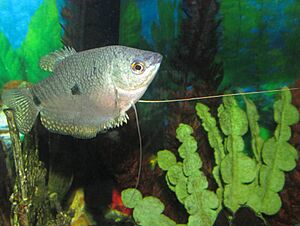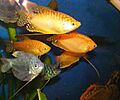Three spot gourami facts for kids
Quick facts for kids Three spot gourami |
|
|---|---|
 |
|
| Conservation status | |
| Scientific classification | |
| Synonyms | |
|
The three spot gourami (Trichopodus trichopterus) is a cool fish from southeastern Asia. People also call it the opaline gourami, blue gourami, or gold gourami. It gets its name from two spots on its body. Its eye is counted as the third spot! This fish is sometimes caught for food in its home areas. It is also raised on farms. Many people also love to keep them in their aquariums. These fish can grow up to 15 cm (about 6 inches) long.
Contents
What's in a Name?
The three spot gourami has a special name because of its spots. It has two clear spots on each side of its body. When you add its eye, that makes three spots! That's how it got its common name. Sometimes, people call it the "hairfin gourami." This name comes from its scientific name, trichopterus. In Malaysia, it's known as the "two-spot gourami."
Popular Types of Gourami
There are many different types of three spot gouramis.
- Opaline gourami has a marbled, swirly pattern.
- Blue gourami is a bright blue color.
- Gold gourami is a shiny yellow color.
- Platinum gourami is a pretty white color.
- Lavender gourami is a mix of blue and gold, making it look purple.
Where Gouramis Live
Three spot gouramis live in fresh water in southeastern Asia. You can find them in places like Cambodia, Laos, Thailand, and Indonesia. They like calm or slow-moving water. This includes marshes, swamps, and canals. They have also been moved to other places, like the Philippines and India.
Gourami Habits
These fish move around with the seasons. When it floods, they swim into flooded areas like forests. When the dry season comes, they go back to bigger water bodies. Three spot gouramis eat tiny water animals. They also enjoy small crustaceans and insect larvae. Male gouramis build a special bubble nest for their eggs. They protect these nests very fiercely.
Keeping Gouramis in Aquariums
The three spot gourami is a strong and easy-to-care-for fish. They can live with other fish that are about the same size. They should also have a similar calm personality. Male gouramis can be bossy with other males. But they might get shy around very aggressive fish.
Male Gourami Behavior
Male gouramis can be quite aggressive. They might nip the fins of other fish. They often bother fish with long, flowing fins. This includes male guppies, goldfish, and bettas. These fish have long tails and bright colors. Male gouramis see them as rivals for impressing females. Female gouramis are usually calmer. They tend to keep to themselves.
Housing Multiple Gouramis
It's often best not to keep many gouramis together. But sometimes, two gouramis can live together well. This works best if they grew up together. Female siblings often get along. They need enough space to swim freely. One fish might become a bit more dominant. It might grow larger and sometimes chase the other fish. But usually, they get along fine.
Feeding Your Gourami
Three spot gouramis eat many different things. They need both plant-based and meaty foods. You can feed them algae flakes. They also like freeze-dried bloodworms and brine shrimp. Live foods are also good for them. This includes mosquito larvae and daphnia. Giving them a mix of foods keeps them healthy.
Gourami Reproduction
It's easy to tell male and female gouramis apart. Look at their dorsal fin (the fin on their back). The male's dorsal fin is long and pointed. His anal fin is also pointed. The female's fins are shorter and rounded. But sometimes, a female can have a long dorsal fin too.
Breeding Process
When it's time to breed, the male builds a bubble nest. He then tries to attract the female. He swims back and forth, showing off his fins. The female can lay up to 800 eggs! After the eggs are laid, it's best to move the female. The male might become aggressive towards her. The male protects the eggs and the baby fish, called fry. He should be moved once the fry can swim on their own. It's important to change the water often after the eggs hatch. This is especially true in the third week. This helps the baby fish develop their special breathing organ.
Gourami Colors
Three spot gouramis can change their color. Their black spots might fade if they are stressed. This also happens if they are not kept in good conditions. Healthy fish have two bright black spots on each side. But these spots can fade as the fish gets older.
Bred Varieties
There are many types of gouramis bred for aquariums.
- Opaline gouramis have a marbled pattern.
- Platinum or silver gouramis are whitish.
- Blue gouramis are a beautiful blue.
- Golden or gold gouramis are yellow.
- Lavender or amethyst gouramis are purple. They are a mix of blue and gold types.
Varieties
Images for kids







